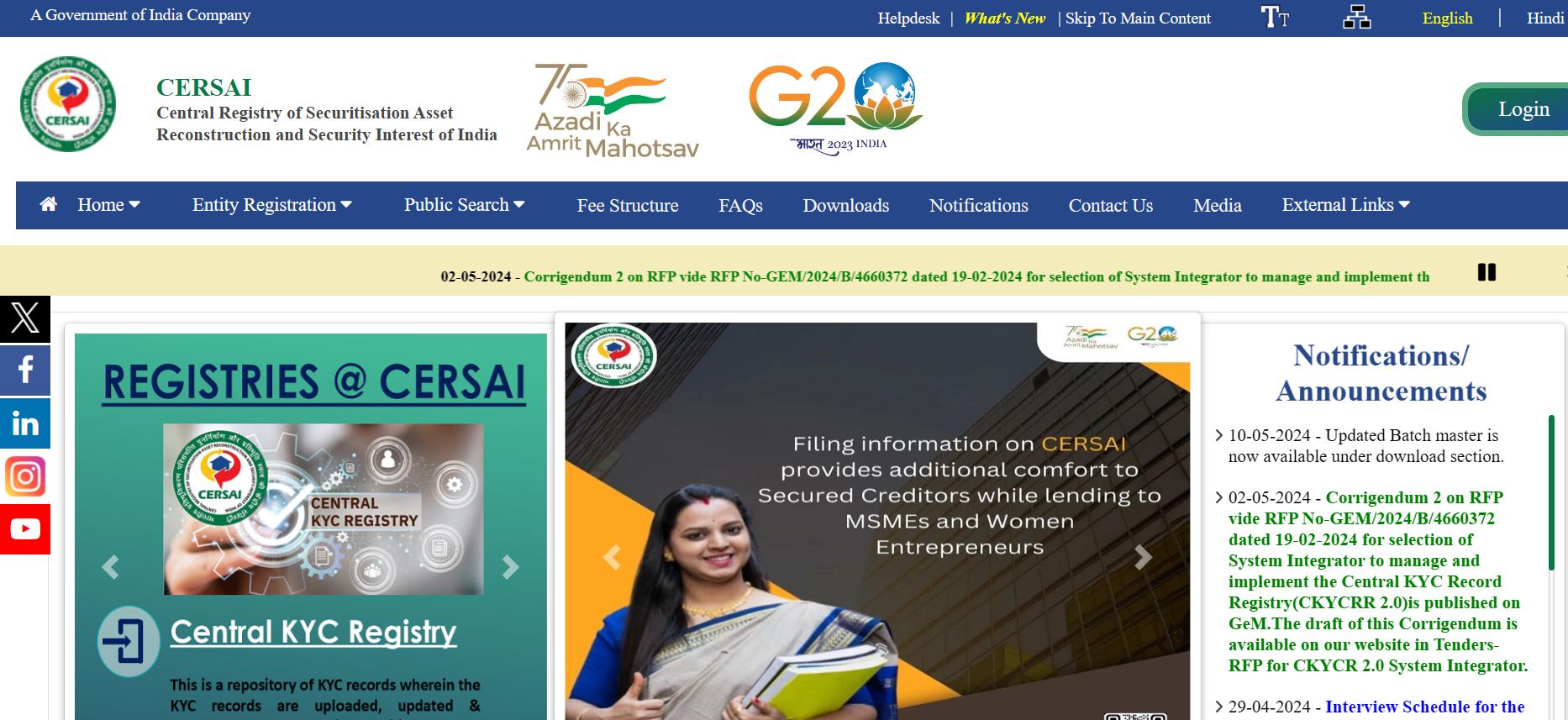



Table of Contents
- About CERSAI
- What is the purpose of CERSAI
- Role of CERSAI
- CERSAI SEARCH Features
- How to Log in to CERSAI
- How To Perform Asset Based Search on CERSAI Portal
- How To Perform Debtor Based Search on CERSAI Portal
- How to do Entity Registration on CERSAI
- Charges involved in CERSAI Portal
- Conclusion
- Faq's
The CERSAI (Central Registry of Securitisation Asset Reconstruction and Security Interest of India) Portal is a crucial online platform established by the Reserve Bank of India (RBI) for managing and monitoring securitization transactions in India.The portal in essence serves as a centralised database to maintain records of all security interests created over various types of properties, both movable and immovable.
The Primary aim of CERSAI is to prevent fraudulent transactions and enhance transparency and accountability in the Indian banking and financial sector. In this article, we will take an in-depth look at CERSAI, including its purpose, objectives, registration process, and more.
Official Website: https://www.cersai.org.in/CERSAI/home.prg
About CERSAI
 Official Website of CERSAI
Official Website of CERSAI
CERSAI, a Government of India company, operates under the licensing of section 8 of the Companies Act, 2013, with its headquarters in New Delhi. Initially established with majority shareholding from the Central Government, Public Sector Banks, and National Housing Bank, CERSAI's primary objective was to manage a Registration System under the SARFAESI Act, 2002.
Over time, CERSAI has evolved to maintain a comprehensive registry covering security interests in immovable, movable, and intangible properties, along with the assignment of receivables. This expansion allows various creditors access to crucial information and the ability to file attachment and court orders, ensuring a detailed overview of encumbered properties. Furthermore, CERSAI now oversees a KYC Registry under the PML Rules 2005, hosting over 70 crore KYC records as of March 31, 2023, benefiting Reporting Entities and their customers significantly.
What is the purpose of CERSAI
 The Primary purpose of the CERSAI portal is to keep records of mortgage applications against property loans
The Primary purpose of the CERSAI portal is to keep records of mortgage applications against property loans
The primary purpose of the portal is to keep records of mortgage applications against property loans in order to prevent cases of fraud by detecting instances where fraudsters take multiple loans from different banks on the same property.
That way it essentially serves as a central registry. Through the CERSAI portal, lenders are allowed to register transactions of asset reconstruction and securitisation, allowing them to verify if the property against which they are disbursing a loan is not used as collateral for another loan by a different bank. Additionally, the CERSAI Portal also helps homebuyers verify if a property is free from any liability or security interest, providing transparency and facilitating informed decisions in real estate transactions.
Role of CERSAI
CERSAI plays a crucial role in the banking sector by promoting transparency and accountability within the financial system. Here are some of the key objectives of the registry:
Preventing Fraudulent Activities: CERSAI helps mitigate fraudulent practices like multiple financing and benami transactions by maintaining a comprehensive record of all securitisation, reconstruction, and security interest transactions.
Enhancing Loan Processing Efficiency: By offering a centralized platform for recording security interests, the CERSAI portal streamlines loan processing, making it easier for lenders to track and manage their assets.
Improving Due Diligence Processes: CERSAI allows lenders to perform thorough due diligence checks on potential borrowers, thereby reducing the risk of defaults and improving the overall quality of loans.
Reducing Litigation Risks: By providing clear and transparent records of all relevant transactions, CERSAI helps minimize litigation risks for lenders.
Protecting Creditors' Rights: The registry safeguards creditors' rights by ensuring that their security interests are duly recorded and protected in compliance with the law.
Promoting Collaboration: CERSAI encourages cooperation among lenders by providing a platform for sharing information and collaborating on asset reconstruction and security interest transactions. It also simplifies the process of loan charge creation, enhancing overall efficiency in the financial sector.
CERSAI SEARCH Features
CERSAI LOGIN
To enter into the CERSAI portal, the user has to login. By logging in a user can access the database of CERSAI that has updated by lenders and other institutions. General Public have two search options - asset based search and debtor based search
How to Log in to CERSAI
To log in to the CERSAI portal, follow these steps:
Step 1: Visit the CERSAI Portal: Navigate to the official CERSAI portal at cersai.com.
Step 2: Click on the Login Button: On the homepage, locate and click on the "Login" button situated at the top right corner of the screen.
Step 3: Enter Your Username and Password: In the designated fields, enter your username and password. Ensure that the credentials you enter are correct, as incorrect entries will result in an error message.
Step 4: After entering your username and password, click on the "Submit" button.
Step 5: Access Your Dashboard: If your login credentials are correct, you will be redirected to your dashboard. From there, you can access the various features and services offered by CERSAI.
By following these steps, you can successfully log in to the CERSAI portal and utilise its functionalities.
How To Perform Asset Based Search on CERSAI Portal
The CERSAI (Central Registry of Securitisation Asset Reconstruction and Security Interest of India) portal offers an asset-based search feature that allows users to verify the status of properties against which security interests have been created
This search function is particularly useful for conducting due diligence during financial transactions, such as when granting loans or verifying the encumbrance status of a property
How to Perform Asset-Based Seach
To perform an asset-based search on the CERSAI portal, users can follow these steps:
Step 1: Visit the official CERSAI website at https://www.cersai.org.in/CERSAI/home.prg
Step 2: Click on the "Public Search" tab on the homepage
Step 3: Select "Asset-Based Search" from the available options
Enter the required details about the asset, such as the property address, survey number, or other unique identifiers
Step 4: Fill in the details
Click on the "Search" button to retrieve the results
Step 5: The asset-based search results will provide information on any security interests or encumbrances registered against the property.
This includes details such as the name of the financial institution that has disbursed the credit, the borrower's details, and the nature of the security interest
By conducting an asset-based search on the CERSAI portal, users can ascertain whether the property they are considering for a financial transaction is free from any existing liabilities or has been used as collateral for another loan by a different lender. This information helps in making informed decisions and reduces the risk of fraudulent activities or legal disputes related to the property.
The asset-based search feature on the CERSAI portal contributes to the overall transparency and efficiency of the financial ecosystem in India.
It enables lenders to verify the status of properties, homebuyers to ensure the property they are purchasing is unencumbered, and all stakeholders to make well-informed decisions in real estate and financial transactions
How To Perform Debtor Based Search on CERSAI Portal
Debtor Based Search on the CERSAI portal allows users to conduct searches based on debtors, providing valuable information on individuals or entities associated with securitization, reconstruction, and security interest transactions
By using this feature, stakeholders can verify the involvement of specific debtors in financial transactions, aiding in due diligence processes and risk assessment. The Debtor Based Search function enables users to track and monitor the financial activities of debtors, ensuring transparency and accountability in the financial system
How To Perform Debtor Based/ Borrower Based Search
To perform a Debtor Based/ Borrower Based Search on the CERSAI portal, users can follow these steps:
Visit the official CERSAI website at the provided link
.Step 1: Navigate to the "Borrower Based Search" section on the homepage.
Step 2:Enter the necessary details such as the debtor's name, identification number, or other relevant information.
Step 3: Initiate the search to retrieve comprehensive data on the debtor's involvement in securitisation and security interest transactions.
Step 4: Review the search results to gain insights into the debtor's financial engagements and associated security interests, facilitating informed decision-making in financial dealings
The Debtor Based Search feature on the CERSAI portal plays a crucial role in enhancing transparency, preventing fraudulent activities, and providing stakeholders with essential information to assess risks and ensure compliance with regulatory requirements in the financial sector
How to do Entity Registration on CERSAI
Users can follow a systematic process outlined by the platform. Here are the steps involved in registering an entity on CERSAI:
Obtain PAN Number
The initial step is to acquire a Permanent Account Number (PAN) from the Income Tax Department, which serves as a unique identifier for taxpayers in India.
Determine Eligibility
Entities must ensure they meet the eligibility criteria set by the Reserve Bank of India (RBI). This includes being a financial institution, bank, or Non-Banking Financial Company (NBFC), possessing a valid PAN number, and meeting the minimum capital adequacy requirements.
Collect Required Documents
The next stage involves gathering the necessary documents as per the requirements.
Below listed are the documents required
- Certificate of incorporation
- Memorandum of association
- Articles of association
- Proof of address
- Identity proof of directors and shareholders
- Audited balance sheet and profit & loss statement
- Certificate of commencement of business
After assembling the required documents, entities need to complete the CERSAI application form available on the official CERSAI website.
Pay Registration Fees
Once the application form is duly filled, entities are required to pay the prescribed registration fees. The fee structure varies based on the type of entity and the nature of the security being registered.
Submit Application
Following the payment of registration fees, entities must submit their applications along with the requisite documents. Upon successful submission, they will receive an acknowledgment receipt.
Wait for Approval
The final step involves waiting for approval from CERSAI. Once the entity's registration is approved, users can log in to the CERSAI portal and commence utilizing its services effecti
Charges involved in CERSAI Portal
Type of Transaction | Fees (Excluding Tax) |
CERSAI Search | ₹10 |
Creation or Modification of Security Interest | ₹50 (for loans up to ₹5 lakhs) <br> ₹100 (for loans above ₹5 lakhs) |
Reconstruction or Securitisation of Financial Assets | ₹500 |
Satisfaction of Securitisation or Reconstruction of Financial Assets | ₹50 |
Assignment of Receivables | ₹10 (for assignments of less than ₹5 lakhs) <br> ₹100 (for assignments of ₹5 lakhs and above) |
Conclusion
The CERSAI Portal represents a significant advancement in the management and monitoring of securitization transactions in India. By providing a centralised, transparent, and accessible platform, CERSAI helps prevent fraudulent activities, enhances the efficiency of loan processing, and protects the interests of creditors. The portal's robust features, including asset-based and debtor-based searches, comprehensive registration processes, and detailed records of security interests, contribute to a more secure and accountable financial system. As the real estate and financial sectors continue to evolve, the CERSAI Portal will play an increasingly vital role in ensuring transparency, reducing risks, and fostering collaboration among stakeholders. This ongoing development underscores CERSAI's commitment to maintaining a secure, efficient, and fraud-free financial environment in India.
explore further
Latest from People
More from Publications
Resources
Dwello, for every home buyer, is a way to go from 'I feel' to 'I know', at no extra cost.




